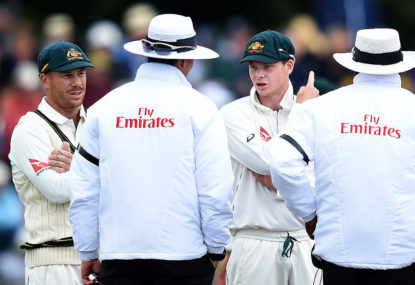WATCH; IPL bowler fuming after getting robbed of near-certain wicket by... Spider-Cam
Harshal Patel was not a happy man!

India have pulled off a 2-1 win against Australia in what was one of the best Test series in recent times. Here are five key points.
1. Test cricket is back in the limelight
Amidst the distraction of the ‘hit and giggle’ formats of the game, this series reminded us that Test cricket is still the pinnacle. It was a series that had everything – two excellent sides giving everything, individual battles and genuine animosity between the sides that made for another exhilarating chapter in their modern day rivalry.
There were no cheap wickets, batsmen were made to work hard for their runs and there was an ebb and flow to the test matches that is just impossible to replicate in the shortened forms of the game. We even had a left arm orthodox wrist spinner change the course of the final Test match.
2. Catches win matches
In such a tightly contested series, individual errors had the ability to swing a match. Matt Renshaw’s dropped catch off Saha was one of the key turning points of the final test. Renshaw cannot be blamed for the loss as it could easily be argued that the second innings failure of Australia’s batsmen was the major reason for defeat in Dharmsala. But the stark reality is that following the dropped catch, Saha and Jadeja went on to post a 96-run partnership.
In a Test where the respective tail-end batters struggled to make any runs, their partnership was a match and ultimately series defining one.
3. Umpires were ably supported by technology and together got things just right
The umpires should be congratulated on their performance throughout the series. In difficult conditions, they got most things right and where they did not, the snickometer and DRS system was on hand to bail them out.
I think this was the pinnacle of decision making accuracy where good decisions where made using technological support whilst maintaining respect for the on field umpires. The DRS added great excitement and drama throughout the series. The major question for the ICC is whether a review should be returned to the challenging team when it is an umpire’s call.
It is unfair that a bowling team challenges a LBW decision, ball tracking shows it to be hitting the stumps but with sufficient doubt it goes back to umpires call and thus given not out. The converse is also an issue for the batting team.
In these situations, I believe the challenging team should get back their review and it is time for the ICC to make this change.

4. Spinners thrive on bounce
It was fantastic to see fast and slow bowlers alike get amongst the wickets. Josh Hazelwood bowled with metronomic accuracy and Pat Cummins was at times unplayable with his bouncers and change up deliveries.
Yadav’s opening spell on the third day was breathtaking. It was a pleasure to see Yadav bowl with pace, accuracy and menace – three terms not usually synonymous with Indian pace bowlers. Yet for all their hard toil, it was the spinners that took the bulk of the wickets for both teams.
Steve O’Keefe and Nathan Lyon were excellent for extended periods during the series. O’Keefe had a brilliant first Test but then sacrificed his game to hold up an end in the third.
Jadeja was outstanding, overshadowing Ravi Ashwin as he pushed his case to be India’s number 1 spin bowler. The key ingredient for all the finger spinners was bounce. Whether it was uneven bounce seen in the first two Tests or the more conventional bounce seen in the last test, Lyon and company were at times unplayable when the pitches offered bounce.
Take out this factor and their effectiveness was muted.
5. All the talk about abandoning the coin toss and poor quality pitches was ultimately a non-event
Demands for the coin toss to be omitted were ultimately unfounded. Australia ended up winning three out of the four tosses and still lost the series. The coin toss has been part of the game for decades and there is no need to change it on the basis of one Test.
The Pune pitch was poor but offered Australia its only win of the series. For all the furore surrounding Indian pitches, India proved victorious on a spinning pitch in Bangalore, came close to winning in Ranchi on a flat track and won the series batting second on a bouncy pitch that offered little turn.
The variability of pitches was a real plus as they offered assistance to spinners, pace bowlers and batsmen during various stages of the series. This provided a fascinating variety of battles between bat and ball.